Holistic wellness focuses on the connection between mind, body, and spirit. This approach aims to restore balance and promote overall health. One method gaining attention is energy healing, which taps into universal energy to support well-being.
Leading medical institutions like Penn Medicine and the Cleveland Clinic are exploring its potential. While scientific research continues, many individuals share positive personal experiences. This practice is often used alongside conventional treatments, especially in cancer care, as per NCCIH guidelines.
Techniques like Reiki and acupuncture are popular examples. These methods are non-invasive and known for their relaxation benefits. Melissa Evans Persensky, a Reiki practitioner, highlights its transformative impact on her life.
Energy healing is not a replacement for traditional medicine but a complementary therapy. It offers a unique way to enhance health and vitality. Let’s dive deeper into its history, principles, and techniques.
Key Takeaways
- Holistic wellness connects mind, body, and spirit for better health.
- Energy healing is gaining recognition in medical settings.
- It complements conventional treatments, especially in cancer care.
- Techniques like Reiki and acupuncture are widely used.
- Non-invasive and relaxing, it supports overall well-being.
Introduction to Energy Healing
Rooted in ancient traditions, energy healing has evolved into a modern wellness practice. Its origins trace back thousands of years, with techniques like Japanese Reiki and Chinese qi forming the foundation. These methods focus on balancing the body and promoting natural healing.
Today, this practice is gaining traction in US healthcare. Research by the NCCIH highlights its integration into medical settings. Unlike Western medicine, which targets physical symptoms, energy healing emphasizes holistic well-being.

Dr. Mikao Usui, the founder of Reiki, introduced principles that guide this therapy. His work emphasizes the importance of energy flow for health. Hospitals across the US are now adopting these methods, with 47% incorporating complementary practices.
The alternative medicine market, valued at $4.2 billion, reflects this growing interest. Clinics like the Cleveland Clinic, with practitioners like Vickie Bodner, are leading the way. However, skepticism remains, particularly around the concept of a “universal life force.”
Scientific debate continues, with researchers exploring measurable energy fields. Despite differing opinions, many find value in this ancient practice. As it bridges the gap between tradition and modernity, energy healing offers a unique approach to wellness.
What is Energy Healing?
Many cultures share a common belief in an invisible energy that sustains life. This universal force, known by different names, forms the foundation of various healing traditions. From Japan’s Reiki to India’s prana and China’s qi, these practices aim to balance and restore vitality.
The Concept of Universal Life Force Energy
Biofield theory suggests that the human body is surrounded by an energy field. This field, often called the biofield, is believed to influence physical and emotional health. When this energy flows freely, it promotes well-being. Blockages, however, are thought to cause illness.
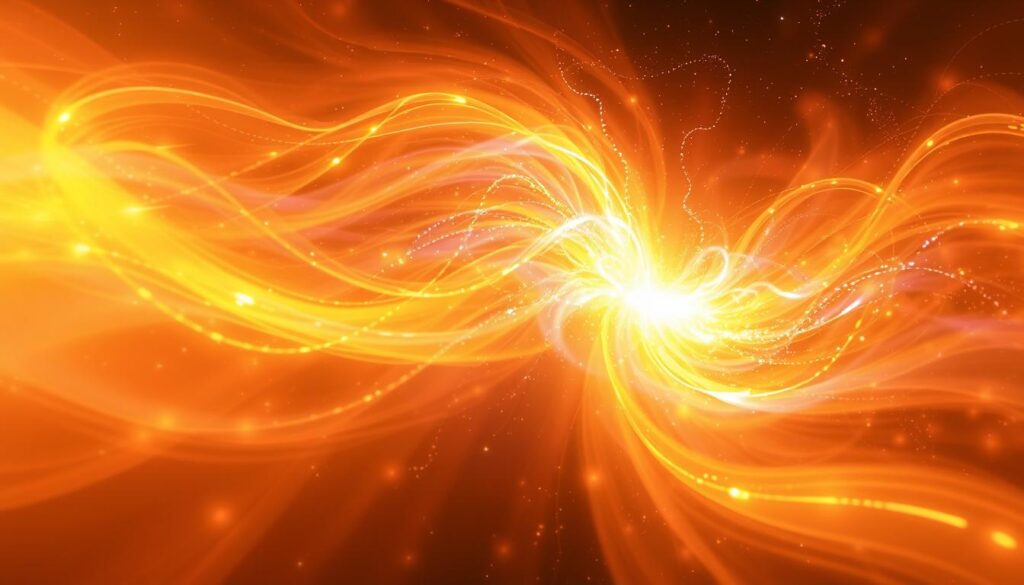
Different cultures have unique interpretations of this force. In Japan, it’s called ki, while in India, it’s known as prana. Traditional Chinese medicine refers to it as qi. Despite the varied names, the core idea remains the same: a vital energy that connects all living things.
A 2021 study on energy medicine showed measurable physiological changes, including reduced stress levels. Patients often report sensations of warmth or tingling during sessions, suggesting movement of this energy. However, quantifying this force scientifically remains a challenge, much like the study of dark matter.
| Culture | Term for Energy | Key Concept |
|---|---|---|
| Japan | Ki | Life force in Reiki |
| India | Prana | Breath of life |
| China | Qi | Vital energy in TCM |
Practitioners like Vickie Bodner describe an “energy presence” during sessions. While some skeptics, like Dr. Saper, caution about the lack of empirical evidence, many individuals find value in these practices. Acupuncture, for example, has measurable effects recognized by the NIH, offering a bridge between tradition and science.
Core Principles of Energy Healing
Balancing the body’s energy is a cornerstone of many traditional practices. This principle revolves around the idea that uninterrupted energy flow is essential for maintaining health. When this flow is disrupted, it can lead to physical discomfort, emotional distress, and fatigue.

Homeostasis, or the optimal state of energy flow, is the goal of these practices. A 2019 study on qigong showed a 58% reduction in pain levels among participants, highlighting the importance of maintaining this balance. Similarly, a 2021 Reiki survey involving over 1,400 sessions reported significant improvements in well-being.
The Role of Energy Flow in Health
Energy blockages can disrupt the natural flow, leading to various issues. Pain, emotional distress, and fatigue are common consequences. The chakra system, a key concept in energy work, emphasizes aligning these centers to restore harmony.
Practitioners act as conduits, facilitating the flow of energy during sessions. This role is often compared to the cardiovascular system, where smooth circulation ensures proper function. Penn Medicine has integrated these protocols into their care, with Dr. Ayubcha noting positive clinical observations.
Individual experiences with energy work vary, but many report sensations of warmth or tingling. These responses suggest the movement of energy, even if it remains challenging to measure scientifically. As research continues, the principles of energy flow remain a vital aspect of holistic wellness.
Types of Energy Healing Practices
From ancient traditions to modern techniques, these methods offer unique benefits. Whether you prefer hands-on approaches or tools-based therapies, there’s a practice to suit your needs. Let’s explore some of the most popular options.
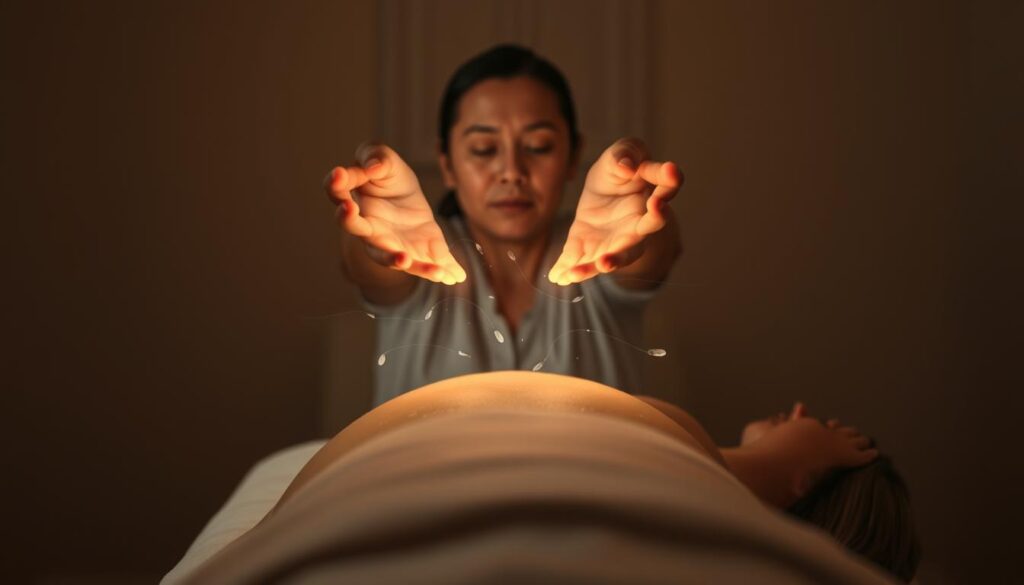
Reiki: A Popular Energy Healing Technique
Originating in 1920s Japan, Reiki was developed by Dr. Mikao Usui. This hands-on method focuses on channeling universal life force to promote balance and relaxation. Practitioners use light touch to guide energy flow, helping to alleviate stress and discomfort.
Training for Reiki involves three mastery levels, each requiring attunement to enhance the practitioner’s ability. Many find this practice transformative, with sessions often leaving them feeling calm and rejuvenated. It’s a gentle yet powerful way to support overall well-being.
Acupuncture and Traditional Chinese Medicine
With roots stretching back 2,500 years, acupuncture is a cornerstone of traditional Chinese medicine. This technique uses FDA-regulated needles to stimulate specific points on the body, promoting natural healing. Research from the NIH highlights its neurochemical effects, which can reduce pain and improve function.
A 2020 meta-analysis of 17,922 patients showed significant benefits, including a 40% reduction in migraine frequency. Acupuncturists must be certified by the NCCAOM, ensuring high standards of care. This practice offers a precise, effective approach to restoring balance.
Other modalities, like qigong and reflexology, also play a role in holistic wellness. For example, a breast cancer trial demonstrated the benefits of reflexology in reducing treatment side effects. Whether you choose Reiki, acupuncture, or another method, these therapies provide valuable tools for enhancing health.
Benefits of Energy Healing
Exploring the potential of holistic practices reveals numerous advantages for overall well-being. These methods, rooted in ancient traditions, are now supported by modern research. From reducing stress to managing chronic pain, the benefits are increasingly recognized.
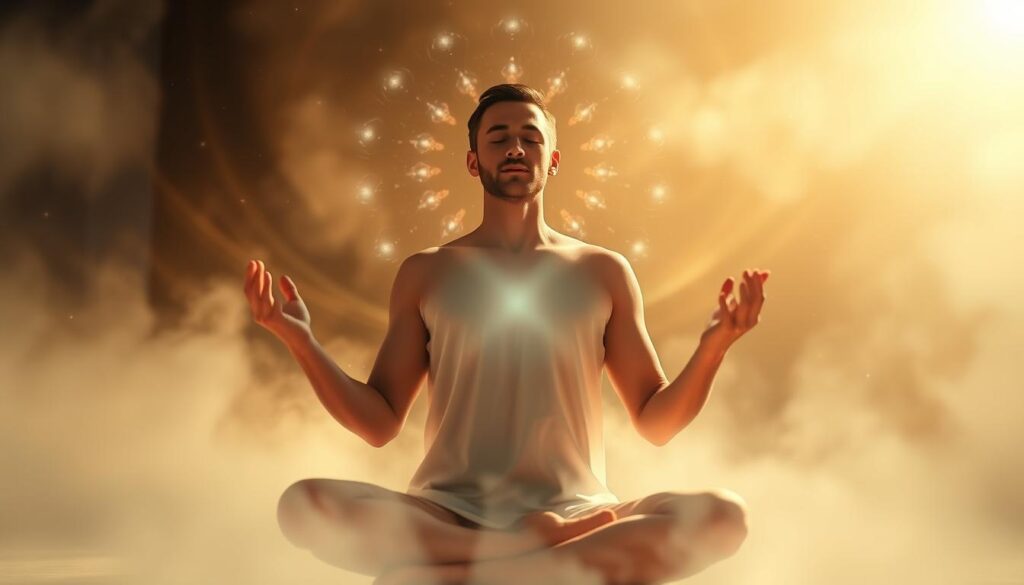
Scientific studies highlight the effectiveness of these practices. For example, a 2018 Reiki study involving 212 participants showed significant pain relief. Another 2021 qigong meta-analysis with 1,200 adolescents reported a 31% reduction in anxiety levels.
Scientific Research on Energy Healing
Research continues to explore the impact of these therapies. A 2017 review of 13 Reiki studies found improvements in depression and anxiety. Similarly, NCCIH cancer care trials have shown mixed but promising results in symptom management.
Key findings include:
- Improved sleep quality in 67% of Reiki recipients.
- Reduced migraine frequency by 40% in acupuncture patients.
- Enhanced immune response observed in acupuncture studies.
“Reiki has been transformative for me. It’s not just about relaxation; it’s about feeling balanced and whole,” says Melissa Evans, a Reiki practitioner.
Despite these benefits, limitations exist. Small sample sizes and placebo effects are common challenges in research. Ongoing clinical trials at institutions like UPenn aim to address these gaps.
While these practices offer valuable support, they should not replace conventional treatments. Instead, they serve as complementary therapies, enhancing overall health and well-being.
How Energy Healing Works
Understanding the mechanics behind holistic therapies reveals their unique approach to wellness. At the heart of these practices is the practitioner, who acts as a guide to facilitate balance and harmony. Their role is crucial in creating a safe and effective environment for therapy.
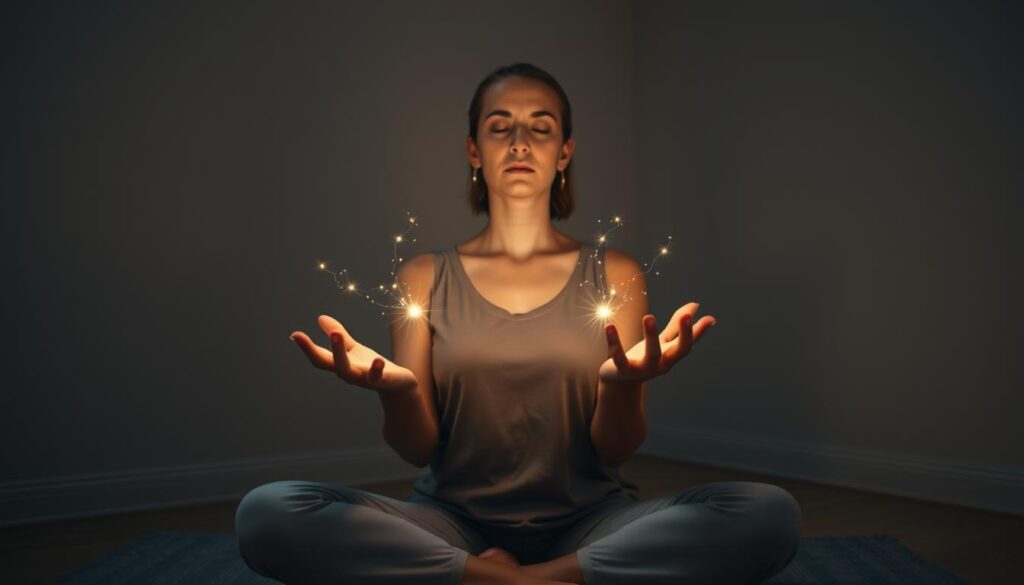
Training for these professionals varies by modality. For example, Reiki practitioners undergo three levels of mastery, while acupuncturists must complete 3,000+ hours of training and pass NCCAOM exams. This rigorous preparation ensures they are equipped to provide high-quality treatments.
The Role of the Practitioner in Energy Healing
During a session, the practitioner uses their hands or tools to channel energy. Reiki sessions, for instance, involve light touch or hovering over the body to guide energy flow. Acupuncture, on the other hand, uses precise needle placement to stimulate specific points.
The environment plays a key role in the experience. Soft lighting, calming music, and a comfortable temperature help clients relax. Vickie Bodner, a Reiki expert, describes entering a trance-like state during sessions, enhancing her ability to connect with clients.
| Aspect | Reiki | Acupuncture |
|---|---|---|
| Approach | Non-directive | Targeted |
| Training | Three levels | 3,000+ hours |
| Tools | Hands | Needles |
Ethical codes are also essential. Practitioners must obtain informed consent, review medical history, and maintain confidentiality. Dr. Saper’s analysis highlights the importance of therapeutic interaction, emphasizing trust and professionalism.
Whether through clinical or spiritual approaches, these therapies offer a unique way to support well-being. By combining skill, intuition, and care, practitioners help clients achieve balance and vitality.
Energy Healing for Specific Conditions
Supporting patients through holistic methods has become a vital part of modern healthcare. These practices are now being integrated into treatment plans for specific conditions, offering unique benefits. One area where this approach shines is in cancer care, where it complements conventional treatments to improve quality of life.

Energy Healing in Cancer Care
Research shows that holistic therapies can significantly enhance the well-being of cancer patients. For example, a NCI-funded breast cancer reflexology study reported a 34% improvement in symptoms. Techniques like Reiki are particularly effective post-mastectomy, helping patients manage pain and emotional stress.
These methods are non-invasive, making them ideal for sensitive patients. They can be easily integrated into chemo or radiation schedules, providing relief without disrupting treatment plans. Hospitals like Memorial Sloan Kettering have incorporated these practices into their programs, recognizing their value in patient care.
Energy work also addresses treatment side effects, such as fatigue and nausea. Scar tissue techniques, for instance, help reduce discomfort and promote healing. Emotional support is another key benefit, offering patients a sense of calm during challenging times.
“Reiki has been a game-changer for me. It’s not just about physical relief; it’s about feeling supported and balanced,” says Arizola, a Penn Medicine patient.
However, it’s important to note that these therapies should not replace conventional treatments. Instead, they serve as complementary tools, enhancing overall care. Below is a comparison of how different hospitals integrate these practices:
| Hospital | Program | Benefits |
|---|---|---|
| Memorial Sloan Kettering | Reiki and Reflexology | Pain management, emotional support |
| Penn Medicine | Holistic Cancer Care | Improved quality of life, reduced side effects |
| Cleveland Clinic | Integrative Medicine | Stress reduction, enhanced well-being |
As research continues, the role of holistic practices in cancer care is becoming clearer. These methods offer a compassionate, effective way to support patients on their healing journey.
Getting Started with Energy Healing
Embarking on a holistic journey can transform your approach to well-being. Whether you’re new to these practices or looking to deepen your experience, understanding what to expect can make the process smoother and more rewarding.
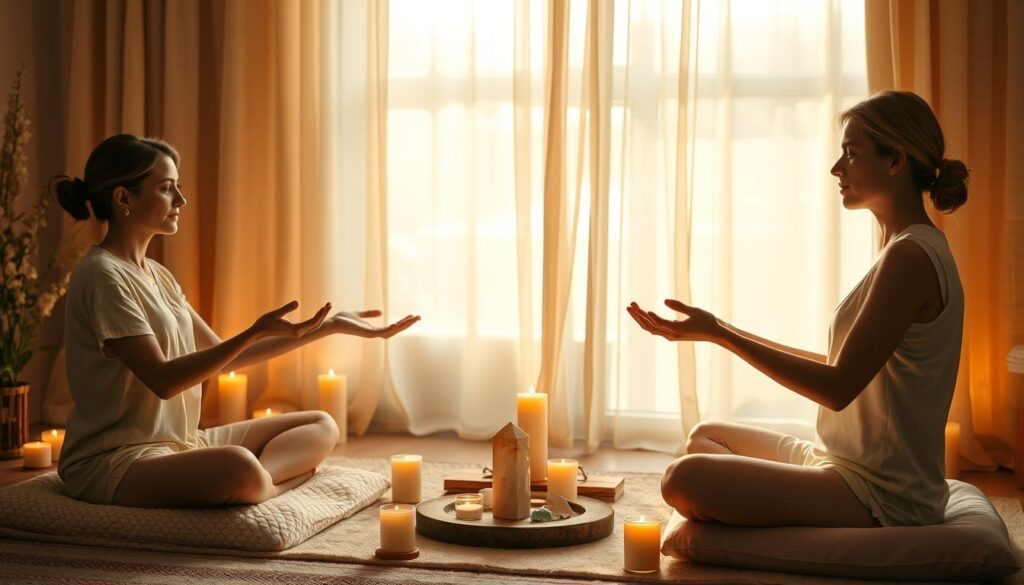
Preparing for Your First Session
Before your session, wear loose, comfortable clothing to allow for easy movement. Staying hydrated is also key, as it helps your body respond better to the experience. Many practitioners recommend avoiding heavy meals beforehand to ensure you feel light and relaxed.
During the initial consultation, your practitioner will discuss your goals and any areas of concern. This step ensures the session is tailored to your needs, whether you’re seeking relief from stress or looking to balance your mind and body.
What Happens During a Session?
Each session is unique, but most involve a combination of techniques like Reiki or acupressure. You may lie on a massage table or sit comfortably in a chair. The practitioner uses light touch or hovers their hands over your body to guide energy flow.
Some people report feeling warmth, tingling, or a sense of deep relaxation. Emotional releases are also common, as the body processes stored tension. These responses are natural and part of the healing process.
Post-Session Care and Recommendations
After your session, take time to rest and reflect. Drinking water helps flush out toxins, while journaling can capture any insights or emotions that arise. Many practitioners suggest scheduling 3-5 sessions to fully experience the cumulative benefits.
If you’re considering Reiki, note that an attunement period may follow your first session. This allows your body to integrate the energy shifts. For those exploring acupuncture, self-care practices like gentle stretching can enhance the effects.
| Setting | Benefits |
|---|---|
| Spa | Relaxing atmosphere, ideal for stress relief |
| Clinic | Professional environment, tailored to specific needs |
Insurance coverage varies, so check with your provider before booking. Asking questions about the practitioner’s training and approach can also help you feel more confident. For more insights into the role of psychic energy in these practices, explore our detailed guide.
Conclusion
Exploring holistic methods can enhance your journey toward better health. These practices, like Reiki and acupuncture, complement traditional treatments, offering a unique path to balance and well-being. Research highlights their benefits, from reducing stress to improving quality of life.
It’s essential to discuss these options with your healthcare provider. Many insurance plans now cover such therapies, and Medicare acceptance is growing. Combining them with yoga or meditation can amplify their effects.
Individual experiences vary, but many find these practices transformative. For more insights, visit the NCCIH website. As Melissa Evans Persensky shares, “It’s about feeling good and whole.”
Ready to start? Book your first session today and take a step toward a healthier, more balanced life.

